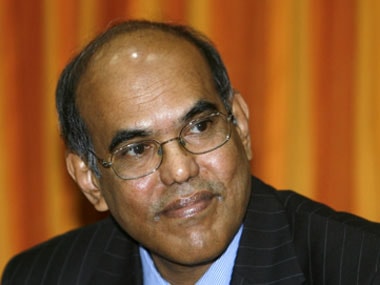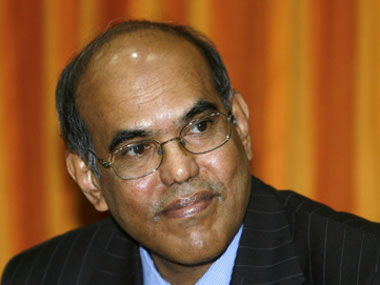The government’s zero-loss argument in the 2G spectrum scam, which is fast becoming the central line of defence for everyone from A Raja to the PM and to the current and former finance ministers, is not going to be easy to defend.
Reason: The Central Bureau of Investigation (CBI), which has put the loss from selling 2G spectrum at 2001 prices in 2008 at close to Rs 31,000 crore, did not pull this number out of thin air. It got this number from former Finance Secretary and present Reserve Bank Governor Duvvuri Subbarao.
In his six-page submission, which is listed as a ‘relied-upon document’ with the serial number 106, Subbarao has applied a methodology and calculated the loss through selling 2G spectrum at 2001 prices to be in the vicinity of Rs 31,000 crore. Subbarao’s submission is a legal document now and has been submitted to the Supreme Court along with the CBI charge-sheet.
[caption id=“attachment_92195” align=“alignleft” width=“380” caption=“In his six-page submission, which is listed as a ‘relied-upon document’ with the serial number 106, Subbarao has applied a methodology and calculated the loss through selling 2G spectrum at 2001 prices to be in the vicinity of Rs 31,000 crore.”]
 [/caption]
[/caption]
The CBI has also listed Subbarao as a witness along with his six-page submission. This means the RBI governor may have to appear in court during the trial to discuss how he arrived at the Rs 31,000 crore figure. If the court is convinced about his argument, it will be tough for the government to claim that the 2G spectrum scam wasn’t a case of zero revenue loss, as claimed by Communications Minister Kapil Sibal and recently by the Telecom Regulatory Authority of India (Trai).
However, the argument that the loss was part of policy remains valid - as policy decisions need not be determined solely by revenue loss considerations.
Nevertheless, the denting of the zero-loss case will weaken the moral argument of the government that the policy was evolved in good faith.
Revenue loss figures in the 2G scam range from zero (Department of Telecom affidavit and Kapil Sibal’s claim) to Rs 30,984.55 crore (the CBI’s) to Rs 1,76,000 crore (the Comptroller and Auditor General’s upper-end estimate based on 3G auction prices).
The latest claimant on 2G revenue losses is Trai, whose secretary RK Arnold, in his two-page forwarding letter along with the Trai report, told the CBI that the government had not lost a penny by selling 2G spectrum in 2008 at 2001 prices.
The Department of Telecom (DOT) had also filed an affidavit saying that there was zero-loss in the sale of 2G spectrum as it was a policy decision. The zero-loss line became more pronounced when a note from the finance minister dated 15 January 2008 to the PM revealed that both knew what Raja was upto and that spectrum was being sold at 2001 prices.
Last week, the Supreme Court bench, while taking stock of the progress of CBI investigations into the 2G scam, was quite perplexed on the spectrum pricing issue. It wondered how Kapil Sibal, DoT and Trai claimed zero-loss when the CBI was claiming Rs 31,000 crore. The CBI told the Supreme Court that their calculations and figures had come from Subbarao.
This changed the language of the court almost immediately. The court said: “We are surprised by that (Trai’s zero-loss) communication. It (Trai) is treated as an independent body. What they have done recently is a seriously debatable issue.”
That Subbarao calculated 2G losses for the CBI will make things difficult for Kapil Sibal and the likes. Subbarao’s was the most vocal voice against the sale of spectrum at 2001 prices when he was finance secretary during Chidambaram’s stint as finance minister. When telecom was under Dayanidhi Maran, Subbarao had shot off a letter to DoT that the spectrum pricing issue should be put up before the Group of Ministers (GOM) and not decided unilaterally by the communications ministry on its own.
Interestingly, the CBI had first pegged the losses at “more than Rs 22,000 crore” in its first FIR in the 2G scam. 2G spectrum was sold to service providers in 122 circles spread all over India. The CBI found that Swan paid Rs 1,537 crore for 13 circles and Unitech paid Rs 1,658 crore for 22 circles.
These two companies had not even rolled out 2G services when Swan offloaded 45 percent of its shares to Etisalat of UAE for Rs 4,200 crore. And Unitech offloaded 60 percent to Telenor of Norway for Rs 6,100 crore. The estimated loss to the government by the grant of licences to these two companies alone comes to Rs 7,105 crore. On a pro-rata basis, the estimated loss for all 122 circles is more than Rs 22,000 crore.
But Subbarao later calculated the loss figure for the CBI and arrived at a figure of approximately Rs 31,000 crore. The CBI director quoted Subbarao’s figure of Rs 31,000 crore when he appeared before the Joint Parliamentary Committee investigating the 2G scam.
Subbarao’s letters on the telecom issue between 2004 and 2008 reveal that if the entry fee was “not to be revised to reflect the opportunity cost and when competitive bidding for determining entry fee was not followed”, concurrence of the finance ministry “ought to have been taken as per rule 4 of the government of India (transaction of business)” rules because “the matter had financial bearing.”
Raja, clearly, stands condemned for flouting the transaction of business rules, and the PM, and the finance ministry for not insisting that the rules be followed.
)